
Victorian Sterling Silver Tasse de Vin with George III Token
Victorian sterling silver tasse de vin, hallmarked London, 1895, H.W the circular body set with George III 3 Shilling bank of England token, with embossed floral and scroll motifs, with pierced cast cupid handles, total weight 68gm, width 12.5 cm

French Silver Sommelier Tasse de Vin and Saucer, Paris Marks
Heavy French silver sommelier tasse de vin and saucer, of baluster form with raised frieze of acanthus, silver marks to base and Paris retail marks, total weight 265gm

Antique Channel Islands Sterling Silver Cup and Tableware Collection
An antique sterling silver Channel Islands style cup by Francis Higgins of London, circa 1886; three antique sterling silver salt cellars, a Channel Islands silver spoon and wine taster, 19th and 20th century, (6 items), the cup 7.5 cm high, 318 grams…
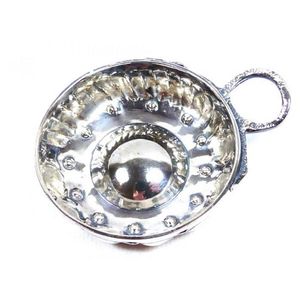
19th Century French Silver Tastevin with Embossed Patterned Sides
19th century tastevin, in French silver having embossed patterned sides and a domed center with small handle. Silver mark worn. Diameter: 6 cm. Weight: 34,4 grams.

French Napoleon III Silver Tastevin - 8cm, 86g
A French silver tastevin with Centralised Napoleon III coin, diameter 8 cm Wt 86g

Lunt Sterling Silver Wine Taster with Scrolling Handle
American sterling silver wine Taster by Lunt traditional form with pierced scrolling handle, approx 94 grams

Gorham Sterling Silver Wine Taster with Scroll Border
American sterling silver wine taster by Gorham with scroll decorated border and pierced handle, approx 94 grams

Pierced handle wine taster in American sterling silver
American sterling silver wine taster traditional form with pierced scrolling handle, approx 88 grams
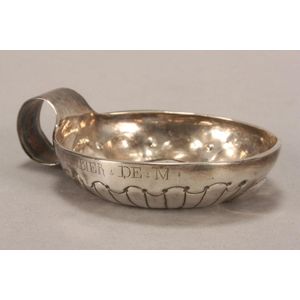
French Silver Wine Cup with Inscription and Decoration
French silver tasse de vin, of circular form, with line and dimple decoration, with look handle inscribed 'G Dubier de M' total weight 60gm

Sterling Silver Wine Taster Cup with Vintners' Crest
Elizabeth II sterling silver wine taster cup London 1963, engraved with crest of Worshipful Company of Vintners,1364-1964, with swan form handle.

Victorian & Modern Sterling Silver Wine Tasting Cups
Wine goblet and wine tasting vessel sterling silver goblet by Danial & Charles Houle. London 1867. Victorian in style and having a git interior. Weight 160.0 grams. A sterling silver wine taste testing cup by PS maker unknown. Birmingham 1993.Weight 39…
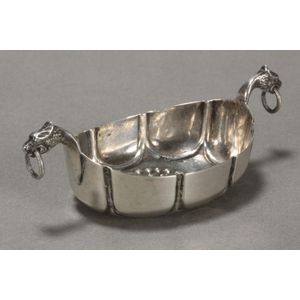
German 830 Silver Dragon Handled Wine Cup
Miniature German 830 silver tasse de vin, hallmarked 830S, Mcc, of lobed form with central embossed medallion, set with twin dragon handles and rings, total weight 21gm, width 9 cm

1966 Sheffield Hallmarked Sterling Silver Wine Cup
English sterling silver tasse de vin, hallmarked Sheffield, 1966, H//Brs (Hardy Brothers), of circular form with a convex base, with twin serpent handle, total weight 127gm, height 3 cm, width 11 cm

Gorham Sterling Silver Wine Cup with Handle
Gorham sterling silver tasse de vin, of squat cylindrical form, with shaped handle, total weight 76gm, height 3.5 cm and

Heart Motif Sterling Silver Wine Cup with Serpent Handle
English sterling silver tasse de vin, hallmarked Birmingham, 1984, Ws&P (Whitehill silver & plate Co), with twin serpent handle, the body decorated with repeating heart motif, total weight 44gm, length 9.5 cm
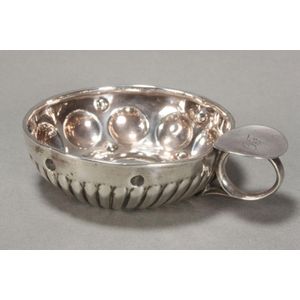
French Silver Wine Cup with Monogram and Dimpled Motifs
19th century French silver tasse de vin, mark rubbed, the thumb piece engraved with monogram 'O.F', the body decorated with dimpled and reeded motifs, total weight 46gm, length 9.5 cm

Georgian Silver Wine Cup by Hester Bateman
Rare George III sterling silver tasse de vin, hallmarked London, 1787, Hb (Hester Bateman), of lobed form, with twin c-scroll handles, total weight 61gm, length 8.5 cm

George V Sterling Silver Tastevin Set by Hardy Bros
Set 4 George V hallmarked sterling silver tastevin, Birmingham 1914. By Hardy Bros. In original fitted case. Total silver weight 96g.

French Silver Wine Cup with Serpent Handle and Grapevine Design
French silver tasse de vin, hallmarked, of circular form with serpent form handle and thumb piece, the bowl embossed with grapevine border, accented with beaded border to base, total weight 54gm, length 10.5 cm

Augsburg Marked Scalloped Wine Tasting Dishes
German silver wine tasting dishes in the 17th century style one with Augsburg mark, both have a scalloped form and twin handles, diameter (larger) 12.5 cm (smaller) 6.5 cm, weight 187g

Mexican Silver Wine Tasting Cup with Coat-of-Arms and Fish Handles
A Mexican Hecho a Mano silver wine tasting cup, the circular bowl with relief embossed coat-of-arms to the centre, two stylised fish form handles, stamped marks. 82gm, diameter 9.2 cm

Tiffany Silver Wine Taster #383, 36g
Tiffany sterling silver wine taster marked to base and #383. Weight 36grams

Silver Wine & Liquor Set
Collection of silver wine and liquor items consisting of 4pcs: i) sterling silver wine pourer with stop sterling silver, Birmingham, II) pair sterling silver liquor bottle labels, one reading 'Brandy' one with no inscription III) sterling silver wine…

Victorian silver wine cup with two handles
A Victorian two-handled silver wine tasting cup, London 1892. Diameter 8.5 cm

Miniature Dutch Silver Wine Taster, 833 Mark, 30g, 8cm
Miniature Dutch silver wine taster 833 mark, 30g 8 cm handle to handle

French Silver Serpent Handle Wine Taster, 19th Century
A French silver wine Taster early 19th century, circular in form with a looped serpent handle, inscribed name to rim 'I. Derouet ', hallmarked J.R to underside, approximately 58 gms silver, 1 cm high, 10.5 cm total width

French Silver Wine Taster with Serpent Handle
A French silver wine Taster early 19th century, circular in form with a looped serpent handle, inscribed name to rim 'A. Vidal a Mareuge Ln. ', hallmarked J.P to underside, approximately 120 gms silver, 2 cm high, 10.5 cm total width

18th Century French Silver Wine Taster
A French 18th century silver wine Taster c. 1760, with a plain beaten silver bowl and attached juxtaposed twisted snake ring handle. Impressed marks. Paris c. 1760. Maker: George Saint Martin. Length 10.3 cm. Weight 74 grams
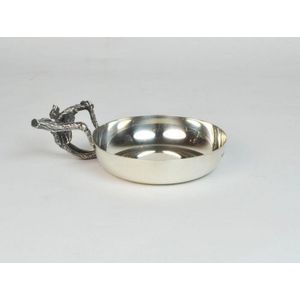
1976 London Sterling Silver Wine Tasting Cup by Anthony Elson
A sterling silver Tastevin - wine tasting cup 1976 London, the mark of Anthony Elson bowl diameter 8.8 cm, weight: 117gms

Sterling Silver Porringer Form Taste de Vin Pair
Pair of novelty taste de vin in a 18th century Porringer form, sterling silver marked H Bros, Birmingham, 1913, approx 38g
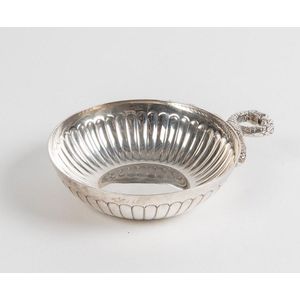
Odell Sterling Silver Tastevin with Double Snake Handle
A sterling silver tastevin with embossed fluting and double snake loop handle, by John Henry Odell, London 1969, 11 wide, 95 grams

19th Century French Silver Tastevin with Dimples and Beading
A small French silver tastevin embossed with dimples and beading, 19th century, maker's mark 'Af', 8 cm wide, 21 grams
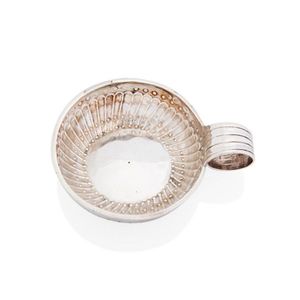
French Silver Tastevin with Swirled Flutes and Engraved Initials
A French silver tastevin embossed with swirled flutes, beading and with engraved initials, 1798/1809, makers mark 'Ljt', 17 cm wide, 76 grams

German Silver Double Tastevin with Flutes and Dimples
A rare German silver double tastevin embossed with flutes and dimples, 19th century, maker's mark 'Svc', 17 cm wide opened, 136 grams
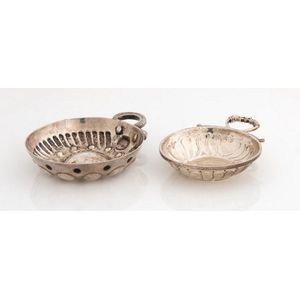
Silver Tastevins with Fluting and Snake Handles
A sterling silver tastevin with embossed fluting and double snake loop handle by Harrison Brothers & Howson, Birmingham 1990, 9.5 wide, and another with fluting and dimples, 11 cm wide

Spanish Silver Tastevin with Alfonso XII 5 Pesetas Coin
A Spanish silver tastevin set with a Spanish Alfonso XII 1878 5 Pesetas within beading and fluting, 20th century, 11.5 cm, 85 grams
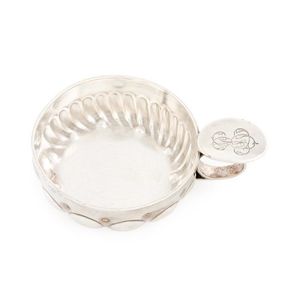
French Silver Tastevin with Fluted Design and Engraved Handle
A French silver tastevin embossed with swirled fluting, dimples and beading, the handle engraved with script initials by J. Granvigne, 4 rue Beranger, Paris, late19th century/early 20th century, 11 wide,150 grams
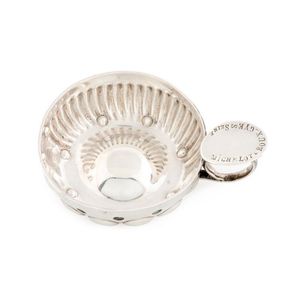
French Silver Tastevin with Swirled Fluting and Beading
A French silver tastevin embossed with swirled fluting, dimples and beading, with ring handle engraved 'Michelot Roux, Gye, Seine', 20 century, 11 wide, 116 grams

French Silver Tastevin with Louis XV Ecu, 19th Century
A French silver tastevin set with a French silver 1765 Louis XV Ecu du 6 Livres within embossed bunches of grapes and vines and beading, with double snake ring handle, 19th century, 11 cm wide, 120 grams

Birmingham 1977 Sterling Silver Tastevin with Snake Handle
A sterling silver tastevin with double snake loop handle, Birmingham 1977, 11 wide, 74 grams

Georgian Silver Tastevin with Embossed Floral Design
A George V Britannia standard silver tastevin with embossed flower heads, fruit and beading and two loop handles by Harry Freeman, London 1912, 12 cm wide, 62 grams
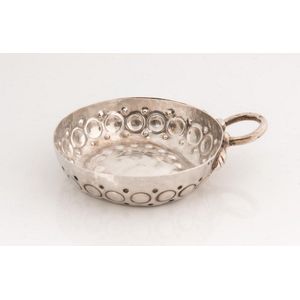
French Silver Tastevin with Double Snake Handle, 18th Century
A French silver tastevin, embossed with dimples and beading, and double snake loop handle engraved 'Ch.M. 1791', 18th century, maker's mark 'Li, 12 wide, 98 grams

Pair of 19th Century French Silver Tastevins
Two small French silver tastevins, 19th century, one embossed with swirled fluting and two sized dimples, 9 cm wide, 42 grams and one with swirled fluting, dimples and beading, 9.3 cm wide, 38 grams
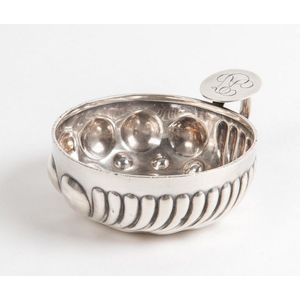
French Silver Tastevin with Swirled Fluting and Dimples
A French silver tastevin embossed with swirled fluting, dimples and beading, with ring handle engraved with initials, 19th century, 10.5 wide, 62 grams

French Silver Grape Tastevin with Snake Handle and Inscription
A small French silver tastevin embossed with bunches of grapes, double snake handle and border with lettering 'Protege La France', 19th century, 7.8 cm wide, 29 grams

French Silver Tastevin with Grape Bunches and Snake Handle
A French silver tastevin by Orfevre Parrot, Paris, circa 1816 with embossed bunches of grapes and snake handle, 9 cm wide, 33 grams

French Silver Tastevin, Paris 1793, Embossed Ribbed Beaded Bowl
A French silver tastevin with embossed ribbed and beaded bowl, Paris, circa 1793, 9.5 cm wide, 58 grams

German Silver Tastevin with Pomegranates and Fruit Embossing
A German silver circular tastevin embossed with pomegranates, fruit and beading, 19th century, 8 cm diameter, 34 grams
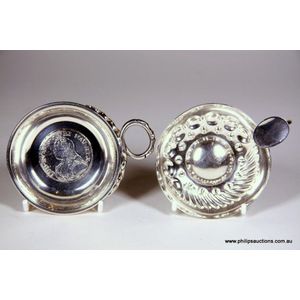
French Silver Tastevins, 19th-20th Century
Two French silver tastevins:950 &. 800 silver, 19th century, with Minerva 2 mark, 18th century coin and indistinct maker's mark, circa 1920 with Minerva 1 mark of fineness and maker's mark for Henri Brille. the wine tasters of typical form, one centred…

Tiffany Wine Taster with Pierced Handle
A Tiffany sterling silver porringer styled wine Taster, 20th century American, pattern number 385 and maker's marks for Tiffany & Co, the small porringer of bleeding bowl form with a pierced handle in the 17th century manner; marked underside and with…

Sterling Silver Plymouth Wine Taster
US Plymouth silver wine Taster. Marked to base 'Rosebud. Sterling', width 82 cm diameter 11 cm

Louis XIV Silver Ecu Tastevin by Alexandre Vaguer, Paris
A French silver tastevin set with a Louis XIV silver Ecu (1643-1715) by Alexandre Vaguer, Rue de Temple, Paris circa 1895. 11 cm wide, 95 grams

19th Century European Silver Wine Taster Cup with Snake Handle
A 19th century European silver wine taster cup similar to above, snake handle, engraved encircling wine bunch frieze.

Dutch Silver Wine Taster Cup with Coin Base
A 19th century Dutch silver wine taster cup, circular bold form with snake loop handle, an 1845 Dutch 1 guilder silver coin set to the base. 96gms. Diameter 8.5 cm

Minerve hallmarked French silver tasse de vin, 100g, 8.5cm
French Silver tasse de vin hallmarked with Minerve. Approx 100 grams, approx 8.5 cm dia

French Minerve Hallmarked Silver Wine Taster
French Silver wine taster hallmarked with Minerve. Approx 50 grams. Approx 5.5 cm dia

Arts & Crafts Sterling Silver Dish, London 1903 (Repaired)
Sterling silver Arts & Crafts three handled dish (possibly a tastevin) London 1903 - one handle repaired

French 19th Century Silver Wine Taster
A silver wine taster (tastevin), French, 19th century. 8.5 cm diameter.

Edwardian Wine Tasting Cup & Elkington Bon Bon Dish
Edwardian sterling silver wine tasting cup, hallmarked Chester 1906, together with an Elkington sterling silver bon bon dish, weighs 286g approx

Birmingham Hallmarked Sterling Silver Wine Taster Cup
Sterling silver wine taster cup, hallmarked Birmingham 1964, maker RWB Richard Woodman Burbridge, width 11 cm, height 3 cm, 82 grams approx.

French Minerve Hallmarked Silver Tasse de Vin
French Silver tasse de vin hallmarked with Minerve. Approx 60 grams

Minerve hallmarked French silver tasse de vin (80g)
French silver tasse de vin hallmarked with Minerve. Approx 80 grams

17th Century French Silver Wine Taster with Louis XIII Coin
French silver wine taster, late 17th century set with a Louis XIII half Ecu coin c1694.

Antique French Tasse de Vin with Hand Grips Set
Three antique French Tasse de vin, each with cast applied hand grips (3)

Sterling silver wine dish with heart petal motif & snake handle
A sterling silver wine tasting dish with indented heart shaped petal motif and juxtaposed snake's head handle. Maker JS. London, 1970. Width 10 cm
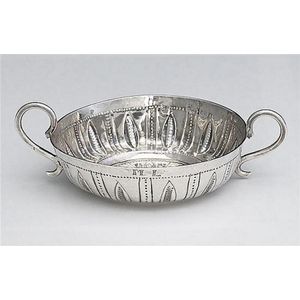
1652 Commonwealth Sterling Silver Wine Taster
A rare sterling silver Commonwealth wine taster, maker World War, London, 1652 of typical circular form, with fine stylized leaf motif throughout, scroll handles and intials Ml to the rim 61.2GM, 9 cm diameter

Embossed Grape Vine Wine Tasting Cup, London 1918
Sterling silver heavy gauge pedestal based grape vine embossed wine tasting cup with handle. London 1918
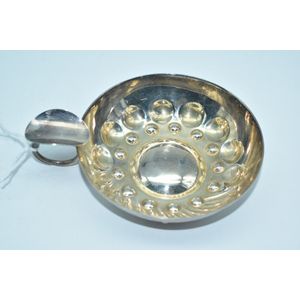
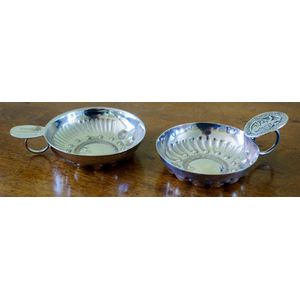









 Loading more...
Loading more...